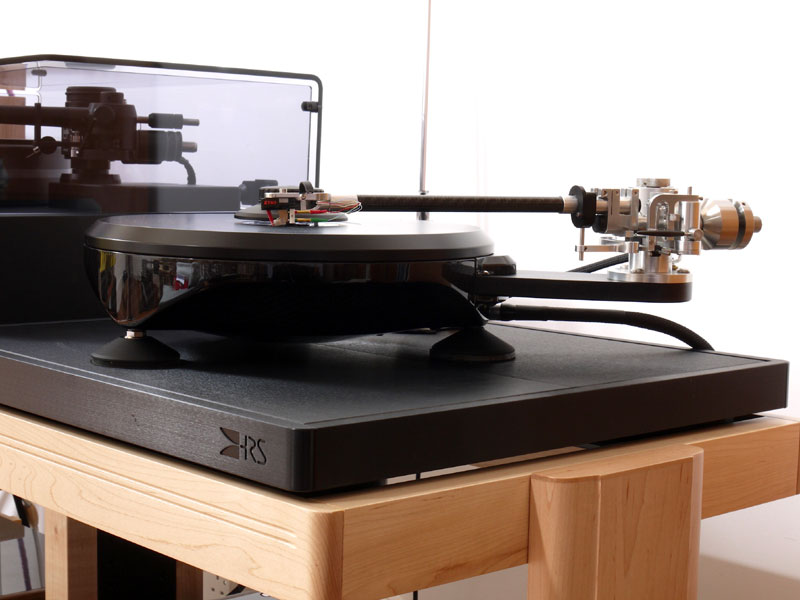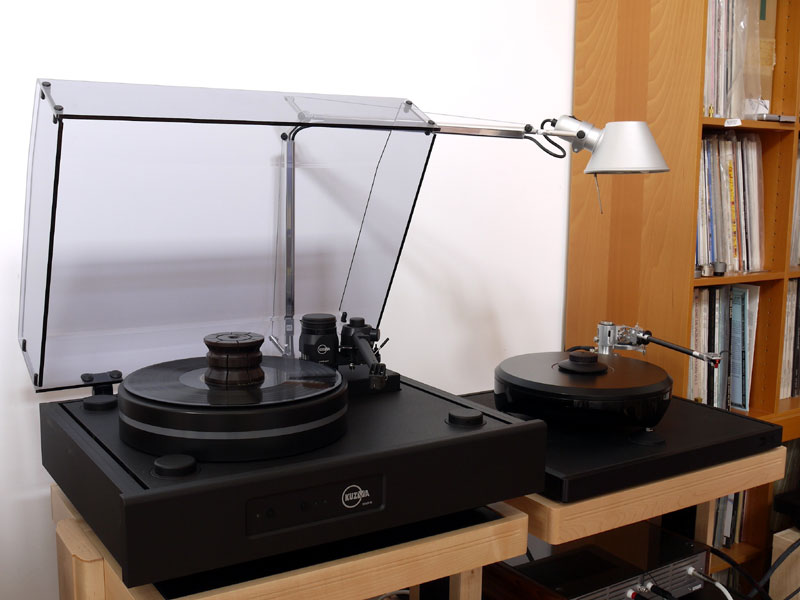Little or Large?
’ve just spent a few pleasurable hours unpacking and setting up the $23,800 Grand Prix Audio (GPA) Monaco 1.5 turntable. I reviewed the original model getting on for ten years ago, and it left a deep and lasting impression on me. Opening the crate this time around, I was assailed by a wave of fuzzy nostalgia. As soon as I started to free the turntable’s components from their wood-and-foam sarcophagus, I was reminded of exactly what I liked so much about this product.
Of course, it has to be said that the original Monaco wasn’t just a remarkably fine-sounding turntable; its sound was remarkable in its own right, reestablishing (at least in my mind) the viability of direct drive. Combine its unrivalled speed stability with a sophisticated engineering and materials package that achieved previously unheard levels of neutrality from a record player and you have a genuinely groundbreaking, benchmark-setting product, one that could and should have set the analog world on its ear. Alvin Lloyd, who builds the GPA products, assures me that the 1.5 is a significant advance over the original ‘table: good news indeed, but not the cause of my trip down memory lane. You see, I haven’t actually listened to the latest Monaco as yet -- but still, just handling it makes me feel uncharacteristically affectionate. So what is it about the GPA Monaco that I find so compellingly appealing? Memories of its musical performance obviously play a part, as do the absolutely exquisite fit, finish and engineering, the luxurious tactile quality and seductive, sculpted shape it possesses, the comprehensive, high-quality tools supplied and the setup procedure that isn’t just sorted but uncharacteristically sane -- at least as far as high-end audio goes. Yes, all of those things are factors, but they’re not the thing that stands the Monaco turntable in such splendid isolation from the crowd. That’s the fact that it is so incredibly small -- dwarfed, in fact, by the HRS platform it's sitting on. The base itself is little bigger than the record it’s going to play and stands a mere four inches tall. The tonearm is supported on a narrow outrigger. Even the outboard power supply is no bigger than a dime-store novel. All of this comes from a product that is quite literally packed with precision electronics and high-tech materials and machined to incredible tolerances. How can I put this? Just handling the Monaco’s component parts and assembling the complete ‘table was a joy, but looking at the finished article, that’s when I realized what I really loved about this product. The phrase "small but perfectly formed" could have been coined for this turntable. In every single regard and by any standard, the Monaco is a thing of beauty. So why, despite a worthy reputation, did it remain a fringe product, revered and owned by so few? I suspect the answer to that conundrum is sitting right next to the Grand Prix ‘table in my listening room -- in the not inconsiderable shape of the Kuzma Stabi M ($19,225, $6675 for 4Point tonearm). Now let’s be clear -- I’m not blaming the Kuzma (for which I have an equally strong regard). In its own way, its blast-from-the-past lid, rapid/remote start up and "universal" plinth system make the Stabi M almost as distinctive as the Monaco, as well as being the finest Kuzma ‘table I’ve used, at least until I hear the Stabi XL with its DC drive. But it is big -- and in this case that’s actually what matters. It could just as easily have been the VPI Classic 4 sitting there -- the effect would be exactly the same. By being neat, petite and oh, so discrete, the Monaco wasn’t just swimming against the tide; it got swept right out to sea. When it comes to audio, there’s no escaping the fact that size matters, large is the governing aesthetic, and most audiophiles think (consciously or subconsciously) that big is beautiful. The Grand Prix ‘table isn’t the only design, or even the first design, to offer it’s "frying-pan" form factor -- even if it is the prettiest. Kuzma, Brinkmann and Pro-Ject all offer turntables that follow this format, but -- and it’s a big "but" -- those are all entry-level rather than flagship designs. The GPA Monaco was too small to justify its price tag in a market where all too often performance is measured by the pound -- even if it did represent a considerable sonic bargain.
Yet the more you examine that dominant sizist ideology, the more reason there is to question it. Okay, so when it comes to speakers, size is obviously a major design consideration, but even here the visual impression can be deceptive. Let’s leave clever shaping and visual sleight of hand aside for now. Think about it and what really matters is not the external dimensions of the cabinet, but the internal volume. Use thin-wall construction -- as the Crystal Cable Minissimo and Wilson Benesch Endeavour do -- and suddenly speakers become a lot smaller than convention suggests. The benefits aren’t just limited to aesthetic appeal and saving space either. As long as you don’t compromise structural integrity -- and with clever materials and engineering, there’s no reason you should -- then reducing the sheer amount of matter in the cabinet will also reduce stored energy, which is a major musical plus. Such designs also tend to be lighter; easier to handle, both during assembly and installation; cheaper to ship; and have a lower carbon footprint. No wonder they are becoming increasingly common. But despite that, there’s still a deeply held prejudice that tells us that "a good big 'un will always beat a good little 'un." All you need to do is look at current speaker ranges to see just how closely size equates to price within each family. But the damaging musical, practical and ecological impacts of excess mass aren't just limited to loudspeakers. It’s ironic that many electronics designers are building additional size and weight into their products to increase their perceived value. The problem is, those thick front panels and oversized heatsinks come with a cost too -- and it’s not just monetary. Compare the overbuilt behemoths that constitute most high-end flagship products from Europe or the US with the equivalent designs from Japan’s boutique manufacturers. Brands like Zanden, Kondo and 47 Labs produce products that are undeniably expensive -- yet few of them even begin to approach the sheer size and weight of their Western competition. It’s no coincidence that Japanese audiophiles and designers have long been fascinated by the relationship between physical dimensions and sonic quality, the complex interplay of size and weight -- and sound. Those Japanese products might be compact, but they are reassuringly dense: not nailed-to-the-table heavy, but pleasingly solid to the touch -- with the emphasis on "pleasingly." It bespeaks a far more sophisticated appreciation of the relationship between mechanical, material and electrical factors in audio performance -- an appreciation that can be heard all too clearly in the musical results. All of which raises a question: just how big (and heavy) should an audio product be? The trite answer is, as big (and heavy) as it needs to be -- but no more. Don’t misunderstand the point being made here. Mass matters. You need enough to make your design work and that amount depends on and will vary according to the nature of the design itself. Some design approaches rely on sheer mass and others suffer from it. But at the end of the day, just how close the designer gets to that ideal weight and those ideal dimensions will have a big impact on how musically convincing and engaging that product sounds. Advances in technology and materials engineering make smaller products a very real possibility, often with the advantage of significantly superior performance to boot. Yet how many such products fail to excite or attract customers as a result of the almost universal belief that big is beautiful, and bigger is better? But that might be in the process of changing. Audio manufacturers are collectively wringing their hands and bemoaning the lack of new-generation customers -- while simultaneously producing ever bigger and more costly products to try and keep their heads above water. But digital natives or members of generation "i" have a completely different aesthetic mindset. Growing up alongside the iPod, iPhone and iPad, they appreciate structural integrity, but they also look for compact dimensions and, above all, performance. They have a completely different notion of relative value and, when it comes to notions of design or quality, a completely different aesthetic idiom. Which brings me back to the GPA turntable, one of the
best-kept secrets in audio. How big (and heavy) is the Monaco? Just as big (and heavy) as
it needs to be, and it's all the better for it. Perhaps its time -- and audience -- is
just around the corner. |


